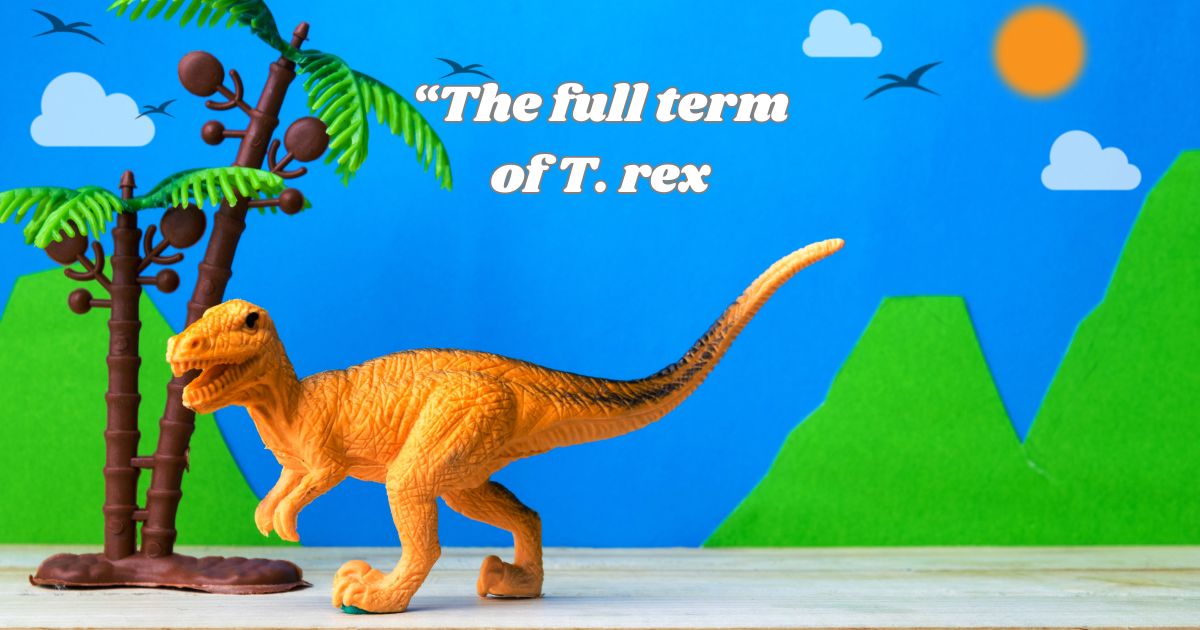“What Does T. rex Mean? Learn the Full Term and Fascinating Facts” The Tyrannosaurus rex, regularly shortened as T. rex, is one of the most popular dinosaurs in history. But what does T. rex cruel? Learn the full term and interesting truths around this extraordinary animal that has captured our creative energies for generations.
T. rex, short for Tyrannosaurus rex, is one of the most famous dinosaurs. His title means “Cruel Reptile King.” Living a long time ago, around 68 to 66 million years ago, it was a huge, carnivorous predator with powerful jaws and solid legs. T. rex lived in North America, and its remarkable fossils provide important information on the lives of the last dinosaurs of the Cretaceous period.
What Does T. rex Mean?
T. rex stands for Tyrannosaurus rex. The title is inferred from Greek and Latin words. “Tyranno” comes from the Greek word “tyrannos,” meaning dictator or lord, and “saurus” is Greek for reptile. “Rex” is Latin for ruler. Hence, Tyrannosaurus rex implies “dictator reptile king.”
Why is Tyrannosaurus rex important?
Logical Significance
1. Pinnacle Predator:
The T. rex was one of the biggest arrive predators to ever exist. Considering its part as an summit predator makes a difference researchers get it the flow of ancient environments and the nourishment chain.
2. Developmental Insights:
Researching the T. rex gives important experiences into the advancement of theropod dinosaurs and their relationship to present day fowls. This association makes a difference paleontologists follow the developmental heredity and get it the adjustments that have happened over millions of years.
3. Fossil Record:
T. rex fossils are among the most well-preserved and various. These fossils permit researchers to think about different viewpoints of its life structures, development designs, and indeed behavior. The broad fossil record of T. rex offers a nitty gritty see into the life of this mammoth predator.
What are real-life examples of Tyrannosaurus rex?

What are real-life examples of Tyrannosaurus rex?
Tyrannosaurus rex, frequently alluded to as T. rex, is one of the most famous dinosaurs known to science and well known culture. Real-life cases of T. rex are found basically through their fossilized remains, which give experiences into their life systems, behavior, and environment. Here are a few eminent real-life cases of T. rex discoveries:
1. Sue the T. rex
Sue is one of the most total and well-preserved T. rex skeletons ever found. Found in 1990 by fossil seeker Sue Hendrickson in South Dakota, this example is housed at the Field Exhibition hall of Common History in Chicago. Sue is over 90% total and has given broad data approximately T. rex’s structure and lifestyle.
2. Stan the T. rex
Stan, found in 1987 by beginner paleontologist Stan Sacrison in South Dakota, is another strikingly total T. rex skeleton. The example is eminent for its well-preserved cranium and has been considered broadly. Stan’s skeleton has been cast and sold to different teach around the world.
3. Jane the Adolescent T. rex
Jane is a youthful T. rex example found in 2001 in Montana by analysts from the Burpee Historical center of Characteristic History. This example has given important bits of knowledge into the development and advancement of T. rex, appearing contrasts between adolescent and grown-up individuals.
4. The Wankel T. rex
Found by Kathy Wankel in 1988 close the Fortification Peck Supply in Montana, the Wankel T. rex is another critical discover. This example is approximately 85% total and was outstanding for its about intaglio arm bones. It is presently portion of the collection at the Smithsonian National Exhibition hall of Characteristic History.
5. Trix the T. rex
Trix is a well-preserved T. rex skeleton found in 2013 in Montana. Named after the Dutch ruler Beatrix, this example is on show at the Naturalis Biodiversity Center in the Netherlands. Trix has contributed to our understanding of T. rex’s physical characteristics and has been utilized for different inquire about studies.
6. Dark Excellence the T. rex
This example was found in 1980 in Alberta, Canada. It is named Dark Magnificence due to the dim color of its fossilized bones, caused by mineralization. Dark Excellence is shown at the Illustrious Tyrrell Historical center of Paleontology and has given important information on the T. rex’s anatomy.
7. Bucky the T. rex
Discovered in 1998 by Bucky Derflinger, a youngster, this example is one of a kind since it incorporates a uncommon furcula (wishbone), which has been significant in understanding the developmental interface between dinosaurs and winged creatures. Bucky is housed at the Children’s Gallery of Indianapolis.
8. Scotty the T. rex
Scotty is one of the biggest and most seasoned known T. rex examples, found in 1991 in Saskatchewan, Canada. This example is momentous for its estimate and age, advertising experiences into the life span and physical stature of these gigantic predators. Scotty is shown at the Regal Saskatchewan Museum.
These real-life illustrations of T. rex have been priceless in progressing our information of this imposing dinosaur. Each revelation includes modern pieces to the confuse of how T. rex lived, chased, and associating with its environment millions of a long time back.
The Noteworthiness of the Name
The title Tyrannosaurus rex superbly typifies the dinosaur’s characteristics. As one of the biggest carnivorous dinosaurs, it genuinely was the ruler of its space. The term “dictator” reflects its dominance and impressive nearness in the ancient world.
Physical Characteristics of T. rex
Size and Weight
Tyrannosaurus rex was an colossal dinosaur, coming to up to 40 feet in length and weighing as much as 9 tons. Its enormous measure made it one of the most scaring predators of its time.
Skull and Teeth
One of the most unmistakable highlights of T. rex is its huge cranium, which may be up to 5 feet long. This cranium housed effective jaws lined with sharp, serrated teeth that may develop up to 12 inches in length. These teeth were culminate for pulverizing bones and tearing through substance, making T. rex an effective hunter.
Arms and Legs
Despite its gigantic measure, T. rex had generally brief arms with as it were two fingers on each hand. In any case, its legs were effective and solid, empowering it to move rapidly and effectively when chasing prey.
T. rex Behavior and Diet

T. rex Behavior and Diet
Hunting Strategies
Tyrannosaurus rex was a imposing predator, but there is continuous talk about approximately its chasing methodologies. A few researchers accept it was an dynamic seeker, utilizing its sharp sense of scent and locate to track and trap prey. Others contend that it may have been more of a forager, nourishing on carcasses cleared out behind by other predators.
Prey and Bolstering Habits
Regardless of its chasing fashion, T. rex had a changed eat less that likely included huge herbivorous dinosaurs such as Triceratops and Edmontosaurus. Its effective jaws and teeth permitted it to smash bones and expend expansive sums of tissue, guaranteeing it got the supplements it required to survive.
T. rex in Well known Culture
Movies and Television
Tyrannosaurus rex has been a staple in prevalent culture for decades, showing up in various motion pictures, tv appears, and books. One of the most famous depictions of T. rex is in the “Jurassic Stop” arrangement, where it is portrayed as a fearsome and brilliantly predator.
Museums and Exhibits
T. rex skeletons are among the most well known shows in normal history galleries around the world. These shows permit individuals to get up near and individual with this extraordinary dinosaur, starting intrigued and interest around the ancient world.
Comparison of T. rex with Other Predators
| Feature | T. rex | Allosaurus | Spinosaurus |
|---|---|---|---|
| Length | Up to 40 feet | Up to 39 feet | Up to 59 feet |
| Weight | Up to 9 tons | Up to 2.5 tons | Up to 7.5 tons |
| Teeth Length | Up to 12 inches | Up to 4 inches | Up to 6 inches |
| Bite Force | Extremely strong | Moderate | Strong |
| Forelimb Length | Very short | Moderate | Long |
| Diet | Carnivorous | Carnivorous | Carnivorous/Piscivorous |
| Speed | Up to 20 mph | Up to 19 mph | Up to 15 mph |
Fascinating Truths Around T. rex
Speed and Movement
Despite its expansive measure, T. rex was shockingly quick. Gauges recommend it might run at speeds of up to 20 miles per hour. This dexterity would have been pivotal for catching prey and avoiding other predators.
Sensory Abilities
Tyrannosaurus rex had exceedingly created tactile capacities. Its expansive eyes given great vision, and its olfactory bulbs were among the biggest of any dinosaur, giving it a sharp sense of scent. These capacities made it a profoundly successful hunter.
Growth and Lifespan
T. rex developed quickly, coming to full estimate in almost 20 a long time. It is accepted to have had a moderately brief life expectancy compared to other dinosaurs, living around 30 a long time. This fast development rate required a significant sum of nourishment, contributing to its ruthless nature.
The Disclosure of T. rex
Initial Discovery
The to begin with halfway skeleton of Tyrannosaurus rex was found in 1902 by paleontologist Barnum Brown in Montana, USA. This revelation was groundbreaking and given the to begin with see into the presence of this gigantic predator.
Subsequent Discoveries
Since the beginning revelation, more T. rex fossils have been found, counting about total skeletons. These revelations have made a difference researchers learn more around its life structures, behavior, and environment.
The Significance of T. rex in Science
Evolutionary Insights
Studying Tyrannosaurus rex has given profitable experiences into the advancement of dinosaurs. Its interesting highlights and adjustments offer clues almost the developmental weights that molded its development.
Clues Around the Ancient World
T. rex fossils too give critical data approximately the ancient world, counting the biological systems in which it lived. By looking at these fossils, researchers can recreate antiquated situations and superior get it the differences of life that existed millions of a long time ago.
Conclusion
In conclusion, Tyrannosaurus rex, or T. rex, genuinely lives up to its title as the “dictator reptile lord.” This impressive predator ruled the ancient world with its enormous measure, effective jaws, and sharp tangible capacities. From its disclosure in the early 20th century to its noticeable part in well known culture, T. rex proceeds to charm our creative energies. By learning what T. rex implies, understanding the full term, and investigating interesting truths around this unimaginable dinosaur, we pick up a more profound appreciation for the ponders of the antiquated world.
In this article, we’ve replied the address, “What Does T. rex Cruel? Learn the Full Term and Intriguing Realities” and given an in-depth see at one of history’s most famous dinosaurs. Whether you’re a dinosaur devotee or basically inquisitive approximately the past, the story of T. rex is beyond any doubt to motivate and interest.
FAQs About “What Does T. rex Mean? Learn the Full Term and Fascinating Facts”
What does T. rex mean?
T. rex stands for Tyrannosaurus rex, which implies “dictator reptile king.”
How huge was T. rex?
T. rex may develop up to 40 feet in length and weigh as much as 9 tons.
What did T. rex eat?
T. rex was a carnivore that likely ate expansive herbivorous dinosaurs such as Triceratops and Edmontosaurus.
How quick might T. rex run?
T. rex may run at speeds of up to 20 miles per hour.
When was T. rex discovered?
The to begin with halfway skeleton of T. rex was found in 1902 by paleontologist Barnum Brown in Montana, USA.

